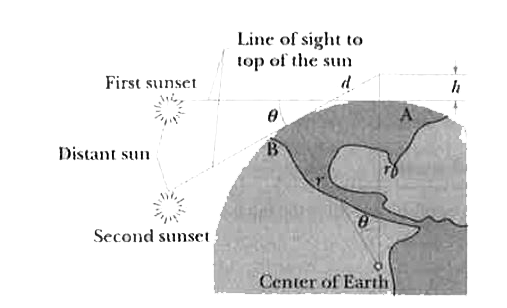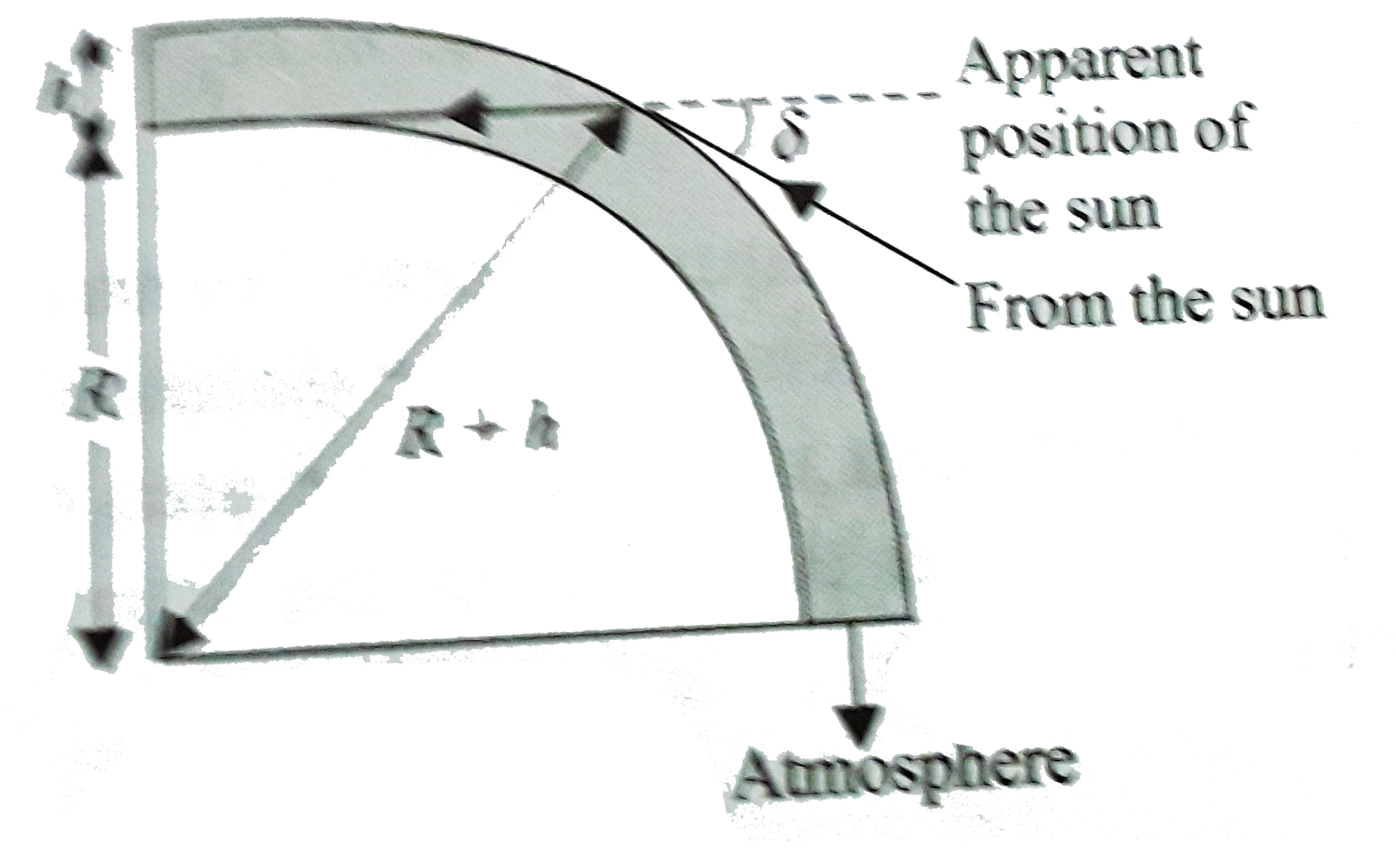When the sun appears to be just on horizon, it is in fact below the horizon. This is because the light from the sun bends when it enters the earth’s atmosphere. Let us assume that atmosphere is uniform and has index of refraction equal to μ. It extends upto a height h(<<R= radius of earth) above the earth’s surface. In absence of atmosphere how late would we see the sunrise compared to what we see now? Take time period of rotation of earth to be T. Calculate this time for following data
R=6400km,μ=1.0003,h=20km,T=24hr.
Video Solution
Text Solution
Just as the Sun disappears, your line of sight to the top of the Sun is tangent to Earth.s surface at point A while lying and point B while standing as shown in Fig Your eyes are located at point A while you are lying, and at height h above point A while you are standing.
Let d represent the distance between point B and the location of your eyes when you are standing, and r the radius of Earth. From Pythagorean theorem, we have
d2+r2=(r+h)2=r2+2rh+h2
d2=2rh+h2 (1−7)
Because the height h is so much smaller than Earth.s radius r, the term h2 is negligible compared to the term 2rh, and we can rewrite Eq. 1-7 as
d2=2rh (1−8)
In Fig. 1-2, the angle between the radii to the two-tangent points A and B is θ, which is also the angle through which the Sun moves about Earth during the measured time t=11.1s. During a full day, which is approximately 24 h, the Sun moves through an angle of 360∘ about Earth. Thus, we can write
θ360∘=t24h
t=11.1s gives us
θ=(360∘)(11.1s)(24h)(60min/h)(60s/min)=0.04625∘.
In Fig. 1-2, we see that d=rtanθ. Substituting this for d in Eq. 1-8 gives us
r2tan2θ=2rh
r=2htan2θ
Substituting θ=0.04625∘andh=1.70m, we find
r=(2)(1.70m)tan20.04625∘=5.22×106m
This radius is within 20% of the accepted value (6.37×106m) for the (mean) radius of Earth.

Fig 1-2 Your line of sight to the top of the setting Sun rotates through the angle θ when you stand up at point A and elevate your eyes by a distance h. (Angle θ and distanc h are exaggerated here for clarity).
|
Updated on:21/07/2023
Topper's Solved these Questions
- BOOK - RESNICK AND HALLIDAYCHAPTER - UNITS AND MEASUREMENT EXERCISE - PROBLEM20videos
UNITS AND MEASUREMENT
- BOOK - RESNICK AND HALLIDAYCHAPTER - UNITS AND MEASUREMENT EXERCISE - PRACTICE QUESTIONS (SINGLE CORRECT CHOICE TYPE)31videos
UNITS AND MEASUREMENT
- BOOK - RESNICK AND HALLIDAYCHAPTER - THE NUCLEUSEXERCISE - PRACTICE QUESTIONS(Integer Type)7videos
THE NUCLEUS
- BOOK - RESNICK AND HALLIDAYCHAPTER - VECTORS EXERCISE - PRACTICE QUESTIONS39videos
VECTORS
Similar Questions
Knowledge Check
- Question 1 - Select One
When the sun is either rising or setting and appears to be just in the horizon, it is in fact below the horizon. The explanation for this seeming paradox is that light from the sun bends slightly when entering the earth's atmosphere as shown in figure. Assume that the atmosphere has uniform density and hence uniform index of refraction n and extends to a height h above the earth's surface, at which point is abruptly stop. The angle δ above the Sun's true position is given by
 Asin−1(nRR+h)Bsin−1(RR+h)Csin−1(nRR+h)+sin−1(RR+h)Dsin−1(nRR+h)−sin−1(RR+h)
Asin−1(nRR+h)Bsin−1(RR+h)Csin−1(nRR+h)+sin−1(RR+h)Dsin−1(nRR+h)−sin−1(RR+h) - Question 2 - Select One
The earth binds the atmosphere because of
AGravityBOxygen between earth and atrnosphereCBoth (a) and (b)DNone - Question 3 - Select One or More
We can see the Sun even when it is little below the horizon because of
AReflection of lightBRefraction of lightCDispersion of lightDAbsorption of light
The height from the surface of earth and electron density of D layer of earth's atmosphere are
View SolutionWe can see the Sun even when it is little below the horizon because of
View SolutionThe layer of atmosphere that is just above the earth's surface is called ______.
View SolutionQuestion Stimulus
What is the main cause of movement in the earth’s atmosphere?View SolutionIf there was no carbon dioxide in the Earth's atmosphere, the temperature of Earth's surface would be :
View Solution

